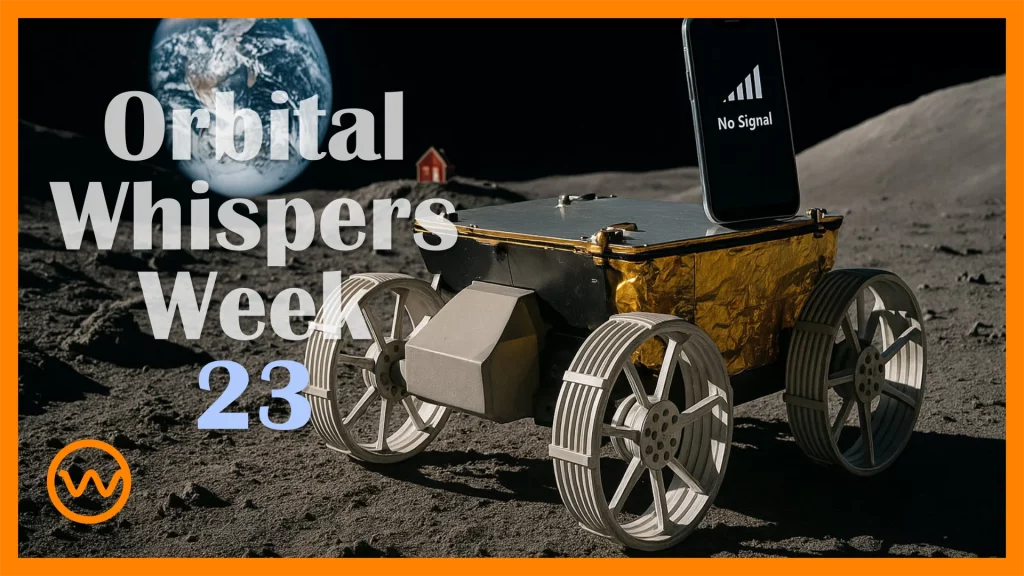ORBITAL WHISPERS
OW23: The Week That Was
Featuring Weddings, Wandering Rovers, and the Art of Signing Your Own Divorce Papers
The battle for orbital dominance makes intergalactic warfare look like a neighborhood squabble. This week, the old guard of GEO and MEO operators donned their armor, ready to reclaim the throne from the LEO insurgents.
Meanwhile, alliances were forged, regulatory dragons were slain, and the maritime sector tried to stay afloat amidst the cosmic chaos. Let’s dive into the week’s most newsworthy nuggets, served with a side of sarcasm and a sprinkle of pop culture references.

SES & Intelsat: Wedding Bells and Whispers
After months of coy glances across the orbital ballroom, SES Satellites and Intelsat are finally making it official. The EU’s antitrust office, known for its steely resolve and lightning pace, is expected to give its unconditional blessing by June 10. No prenup required. No drama. Just a $3.1 billion “strategic alignment” between two of the most venerable names in GEO satellite real estate.
Together, they now control over 100 geostationary satellites and 26 MEO assets, a collection that reads like a retirement home’s asset sheet compared to Starlink’s 6,000 hyperactive LEOs flinging bandwidth from orbit like confetti. But hey, legacy counts for something. Probably.
Let’s not ruin the honeymoon with math.
One can imagine the reception taking place in a carpeted EU boardroom, where someone clinked a glass of sparkling mineral water and gave a toast in legalese. Dress code: business delusional, no tie required, just unwavering faith in multi-orbit futures and a complete disregard for what customers actually want.
“We merged for efficiency,” says the official line. “We merged because we had to,” mutters everyone else.
Still, there’s poetry in it. Two fading GEO aristocrats, arm in arm, gazing wistfully at their lost regulatory exclusivity and remembering the good old days when being above 36,000 km meant something. These days, it just means you’re late to the latency race.
But bless them, they’re going to try.

Eutelsat + Orange: A Self-Signed Love Letter (Now With Extra Ink and Awkward Winks)
This week in corporate origami: Jean-François Fallacher officially became CEO of Eutelsat Group on June 1st, and wouldn’t you know it, Eutelsat and Orange just so happened to sign a multi-year satellite service agreement at the exact same time.
What are the odds?
Rumour has it the paperwork was already halfway through the system before Fallacher even had time to update his LinkedIn title. Did he sign part one of the agreement with his Orange pen, walk across the corridor, grab the Eutelsat letterhead, and countersign with a fresh espresso? If so, it may be the most seamless inter-company negotiation in telecom history. Also, possibly the most conflict-of-interest-adjacent.
Someone really should examine those signatures before the ink dries. It’s one thing to negotiate a contract, it’s another to do it with yourself across two payslips. You can practically hear the legal team hyperventilating into a paper bag somewhere in Paris.
“Do you, Jean-François, take this contract… from yourself?” “I do. And I look forward to a long and profitable relationship… with me.”
As for the deal: Orange gets exclusive resale rights for Eutelsat’s KONNECT VHTS in France and early access to OneWeb’s LEO capacity across Africa and the Middle East. It’s a solid win, if you’re playing Monopoly and already mortgaged your fibre, your DSL, and your dignity.

NASA’s Dragon Recall: Now With 100% More Helium and 0% Apology
Just when SpaceX ’s Dragon capsule was starting to feel like the dependable workhorse of orbital logistics, it decided to impersonate a budget air compressor. NASA confirmed this week that the capsule, which was already on the launchpad and ready to go, developed a helium leak and had to be called back like a mislabelled IKEA chair.
It’s the second helium leak in a month and one of several thruster malfunctions to hit recent missions. You could almost call it a pattern, if NASA weren’t too busy issuing calm, confident statements about “nominal parameters” and “enhanced safety margins.” Translation: “We’ll fix it in post.”
To be clear, this wasn’t the crewed Dragon that carries astronauts, but the cargo version, so nobody was onboard except a few science payloads, some spare ISS plumbing, and possibly Elon’s pride. The mission is now delayed indefinitely while engineers crawl over the capsule with wrenches and crossed fingers.
And in case this all feels eerily familiar, yes, Dragon was almost taken out back and shot earlier this week after Elon threatened to “decommission” it during a Twitter tantrum aimed at Donald Trump. That, too, was walked back after someone at NASA presumably phoned him and said, “We still don’t have a backup, mate.”
“Nominal” is just NASA-speak for “please don’t ask follow-up questions.”
So here we are. The capsule’s grounded, the leaks continue, and the public gets to watch yet another awkward moment in the ever-entertaining love-hate triangle between SpaceX, NASA, a Bromance and reality.

Japan’s Rover: Please Stop Trying
Japan’s lunar ambitions took another nosedive this week, as ispace, inc. ’s second attempt at a Moon landing ended in, well, silence. The uncrewed “Resilience” lander made its descent on June 5, and everything was looking good until the final approach, when it stopped talking. Which, to be fair, is also how most first dates end.
The company suspects a sensor glitch, a propulsion error, or a software hiccup. The rest of us suspect it may have actually landed fine, and is now quietly sitting on the Moon, waiting for someone to explain how direct-to-device signal works when your device is 384,000 kilometers away and not facing Earth.
This marks ispace’s second consecutive mission that made it to the Moon only to ghost ground control. In PR terms, they’ve “advanced technical validation objectives.” In human terms, they’ve now spent two rockets and three press conferences discovering that talking to the Moon is harder than getting a bar of Wi-Fi at a Berlin tech fair.
But don’t worry, more missions are planned. And this time, they might send a satellite first. You know, just in case that helps.
“Mission control to silent lunar module: please call us back. We’re not mad, just worried.”

Ofcom’s D2D Vision: Signal from the Sky, Soonish
This week, Ofcom unveiled its bold new plan to let ordinary smartphones connect to satellites by the end of 2025. Yes, that’s right, your off-the-shelf Android may soon call Grandma from a hilltop in Snowdonia via space. All without the help of a single terrestrial tower. Progress.
This initiative is meant to eliminate so-called “not spots”, rural dead zones where mobile signals disappear, and civilization reverts to smoke signals and shouting. It’s a noble goal, if slightly undermined by the fact that you’ll need clear skies, no buildings, no trees, and ideally no atmosphere to get a stable connection. But let’s not nitpick.
Several companies, Lynk , AST SpaceMobile, Amazon Project Kuiper are already lining up to beam signal salvation from low Earth orbit. And by “lining up”, we mean submitting PowerPoints, pointing at a satellite, and saying, “Look, it works in Guam.”
Ofcom, naturally, is thrilled. They’ve called it a game-changer. Which it would be, if your average user is happy with half-a-bar signal, two-minute latency, and the ability to place a single call per lunar cycle.
But hey, why build rural towers when you can have your phone yell directly into space? It’s the future. Sort of.
Coverage everywhere. Calls that drop nowhere. Data speeds that make pigeons look fast.

Lynk + SES: The D2D Odd Couple
In another episode of Desperation Meets Legacy, Lynk Global and SES have officially decided to hold hands in public. It’s a partnership that feels a bit like pairing a bright-eyed startup intern with a grizzled middle manager who keeps muttering about “back in my day we had Ku-band and we liked it.”
Lynk brings the dream: direct-to-device (D2D) satellite connections using ordinary smartphones, no dongles, no dish hats, just you, your mobile, and the endless void of space. SES, meanwhile, brings… well, orbital parking rights, an aging MEO constellation, and a PR department that really needs a win after mPOWER’s series of “not-quite-there-yet” updates.
The press release paints a bold vision: combining Lynk’s LEO trickery with SES’s global ground infrastructure and mPOWER’s “flexible architecture” (read: it hasn’t shipped, but we swear it’ll be great). But strip away the jargon, and what you really have is Lynk needing a grown-up to vouch for them, and SES needing someone to make them look younger, faster, and not entirely tethered to the 1990s.
Lynk gets scale, spectrum, and manufacturing help. SES gets headlines with the words “direct-to-device” that don’t also include “lagging behind” or “regulatory headache.” Everybody wins, at least until they have to actually deliver something with uptime.
Think of it as a satellite rom-com. One believes in the future. One owns some towers. Together they’ll try to convince investors it’s true love.

SES Open Orbits: Inflight Wi-Fi That Might Actually Work
Turkish Airlines and Thai Airways International just bought tickets for SES’s latest inflight connectivity magic trick: Open Orbits, a broadband system promising to dynamically switch between GEO, MEO, and LEO satellites for “seamless” coverage. Which sounds fantastic, assuming you enjoy seamless handovers between networks that individually struggle to stream YouTube at 720p.
The tech behind the curtain? ThinKom Solutions, Inc.’s ThinAir Ka2517 antenna, a marvel of compact engineering that promises to track anything in orbit, from SES’s mPOWER MEOs to future LEO networks to whatever bizarre elliptical constellation Elon decides to tweet into existence next Tuesday.
The selling point is flexibility. The selling reality is that airlines have signed up for flexibility because reliability is still a few firmware updates away.
Yes, SES promises intelligent traffic steering. Yes, there’s an “open architecture” involved. But passengers have one question: Will it let me watch an episode of Succession without buffering like it’s 2006? Because until the day comes when the Netflix logo loads before the seatbelt sign goes off, it’s still anyone’s guess whether we’re surfing the cloud or just staring into it.
You may now switch on your devices. Whether they’ll do anything useful is another matter.
So yes, SES is innovating. Yes, the airlines are onboard, literally. And yes, your cat video might load at cruising altitude. Just don’t ask how many orbits it bounced through to get to you.

Final Curtain:
Eutelsat’s signing ceremony looked more like corporate cosplay. SES is off to its shotgun wedding. NASA’s Dragon got recalled. Japan buried another rover. And somewhere in Yorkshire, a sheep farmer may someday get a text message from space… if he stands still long enough.
This week’s theme? “Everyone’s pivoting, nobody’s landing.”
FOMO -> Subscribe

